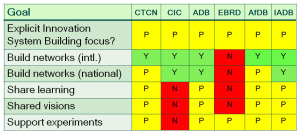Update (1 July 2015): The research described in this blogpost has been written up in an article for the journal Climate Policy:
Ockwell D. and Byrne R. (2015) Improving technology transfer through national systems of innovation: climate relevant innovation-system builders (CRIBs), Climate Policy (open access)
Other publications:
- Working Paper 76 (focused on policy recommendations): CRIBs (Climate Relevant Innovation-system Builders): Policy Recommendations on Fostering National Systems of Innovation under the UNFCCC
- Policy Briefing: CRIBs (Climate Relevant Innovation-system Builders) A powerful new focus for international climate technology policy
- Working Paper 77 (includes discussion of the supporting academic evidence): CRIBs (Climate Relevant Innovation-system Builders): An Effective Way Forward for International Climate Technology Policy
- Resource package: COP21, climate change and sustainability
David Ockwell on a powerful new focus for international climate technology policy

The UN Framework Convention on Climate Change’s Technology Executive Committee (TEC) recently convened a meeting on strengthening National Systems of Innovation in developing countries.
This is possibly the most positive step forward for efforts under the UNFCCC to date. In this blog post, I want to explain why – and provide some key pointers for taking these efforts forward.
The problem with hardware financing
First, a bit of background. Developing countries need the right kind of support to address climate change challenges, and to develop along low carbon, climate resilient trajectories. The UNFCCC is supposed to help this to happen by supporting the transfer and development of climate technologies (technologies for climate change mitigation and adaptation). To date, however, there has been huge frustration at the failure of activities under the Convention to deliver at anything like the speed or scale needed. So why hasn’t it worked?
Research at the STEPS Centre demonstrates that a core reason is the current policy framing of the problem as one requiring ‘hardware financing’. Climate technologies are more expensive than conventional technologies, so market mechanisms are put in place to internalise the positive externalities of climate mitigation and adaptation currently not captured in the market (e.g. the Clean Development Mechanism, CDM, and various financing efforts under the Global Environment Facility, GEF). So these mechanisms help to pay for technologies which might not otherwise be affordable.
All this ignores the fact that technological capabilities are a prerequisite for countries to be able to absorb new technologies.
Sowing seeds
Technological capabilities are like soil in a garden. Without initial efforts to nurture the soil’s fertility, scattering seeds (bits of technology hardware) is unlikely to lead to a flourishing garden (technological change and development).
Moreover, commercial gardening contractors (technology investors) are unlikely to invest effort in sowing seeds in unfertile gardens in the first place.
Hardware financing mechanisms, therefore, serve simply to reinforce the comparative advantages of different countries. The majority of investment from the CDM, for example, went to countries like China (60%) and India (11%) with comparatively high levels of existing technological capabilities – Africa as a whole only received 3% – the amount going to sub-Saharan Africa being smaller still. The CDM also tended to fund established, close to market technologies rather than nurturing the development and uptake of new technologies.
How National Systems of Innovation can help
So how do countries develop the technological capabilities they need to attract technology transfer and development?
The key, according to decades of research in the field of Innovation Studies and more recent work on Socio-Technical Transitions, is to focus on nurturing National Systems of Innovation (NSIs).
NSIs can be understood as the gardens within which the fertile soil is to be nurtured. They provide the context within which all processes of technology development, transfer and uptake occur. National Systems of Innovation encompass the network of actors (e.g. firms, universities, research institutes, government departments, NGOs) within which innovation occurs, and the strength and nature of the relationships between them.
The idea of looking after these gardens – nurturing National Systems of Innovation – would begin to address the problem that hardware financing can’t fix. It could underpin more sustained and widespread transfer and development of climate technologies. As such, it provides a powerful new focus for international policy.
From gardens to gardeners
Moreover, insights from the above literatures suggest the existence of Innovation System Builders – key individuals who act to link actors and institutions up across niches of climate technology activity.
To extend our analogy, these are the gardeners who want their particular garden to thrive, preparing the fertile ground for leaps ahead in technological capability development (see, for example, our research on the off grid solar photovoltaic market in Kenya). This is a powerful insight for policy efforts which could seek to fulfil the role of Innovation System Builders.
A change in thinking?
By convening a two day workshop on NSIs, the Technology Executive Committee – the body responsible for overseeing implementation of the UNFCCC’s Technology Mechanism – has signalled its interest in this powerful way forward for UN climate policy.
The meeting involved presentations from seventeen international experts with significant time set aside for members of the TEC to ask questions and discuss the various issues raised.
In general, the meeting had a positive tone. Members of the TEC demonstrated their understanding of many of the core issues and expressed significant interest in nurturing NSIs as a positive way forward. Perhaps unsurprisingly, the age-old issue of Intellectual Property Rights (IPRs) dominated parts of the conversation – frustrating to watch, given the fact that a focus on NSIs offers a way past this baffling political impasse, which has been so divisive along a North-South axis. And, of course, there was the small issue of there being only one woman amongst the seventeen expert presenters…
What happens now?
According to the TEC’s 2014/15 workplan (pdf) they’ll be giving further consideration to the issue of NSIs in 2015.
Nurturing National Systems of Innovation will take effort and capacity. More of this is needed in some countries and regions than others. Looking at the coverage of existing mechanisms under the UNFCCC and related initiatives (including the World Bank’s Climate Innovation Centres, CICs, and the various Development Bank initiatives funded by the GEF) we can develop a clear picture of where the gaps are.
Table 1 illustrates the coverage of existing mechanisms against the key policy goals which should direct efforts at innovation system building (see our Policy Brief on Low-Carbon Energy policy for further detail). It disaggregates between national and international networking and adds an additional row to signify whether NSI building is an explicit part of any of their remits at present. From the swathe of yellow in Table 1 we can see that it would be possible, with incremental revisions to the existing remit of most of these initiatives, to integrate NSI building across their activities.
Table 1. Coverage of key existing international policy initiatives under the UNFCCC, GEF and World Bank (infoDev) and extent to which they focus on fostering National Systems of Innovation

 Table caption: CTCN=Climate Technology Centre and Network under the UNFCCC; CIC=Climate Innovation Centre under World Bank/infoDev; ADB = GEF funded “Pilot Asia-Pacific Climate Technology Network and Finance Center”, which is being implemented with the Asian Development Bank (ADB) and UNEP; EDRB=GEF funded “Finance and Technology Transfer Centre for Climate Change” by the European Bank for Reconstruction and Development (EBRD); AfDB=GEF funded “Pilot African Climate Technology Finance Center and Network” by the African Development Bank (AfDB) (which includes regional partners that are part of the CTCN consortium); IADB=GEF funded “Climate Technology Transfer Mechanisms and Networks in Latin America and the Caribbean (LAC)” by the Inter-American Development Bank (IADB) which is currently in preparation, again with regional partners that are part of the CTCN consortium.
Table caption: CTCN=Climate Technology Centre and Network under the UNFCCC; CIC=Climate Innovation Centre under World Bank/infoDev; ADB = GEF funded “Pilot Asia-Pacific Climate Technology Network and Finance Center”, which is being implemented with the Asian Development Bank (ADB) and UNEP; EDRB=GEF funded “Finance and Technology Transfer Centre for Climate Change” by the European Bank for Reconstruction and Development (EBRD); AfDB=GEF funded “Pilot African Climate Technology Finance Center and Network” by the African Development Bank (AfDB) (which includes regional partners that are part of the CTCN consortium); IADB=GEF funded “Climate Technology Transfer Mechanisms and Networks in Latin America and the Caribbean (LAC)” by the Inter-American Development Bank (IADB) which is currently in preparation, again with regional partners that are part of the CTCN consortium.
How it works: the detailed version
To see how this might work in detail, we need to look a bit more closely at the mechanisms and bodies involved and what needs to change.
Under the UNFCCC, the key delivery mechanism is the Climate Technology Centre and Network (CTCN). It is here that the Technology Executive Committee has most influence and could make positive recommendations to the UNFCCC Conference of the Parties (COP) for a new approach.
The key thing the CTCN lacks is capacity on the ground in developing countries. At present this capacity consists of National Designated Entities (NDEs), but these are generally civil servants with only a small proportion of their time allocated to their work as an NDE.
What is required is the creation of CRIBs (Climate Related Innovation-system Builders). These would be dedicated institutions on the ground in developing countries who focus explicitly on NSI building, understanding local capacities, identifying opportunities to connect actors up across projects and programmes, across sectors, linking up with and understanding technology users, and so on.
Each CRIB would feed in requests to the Climate Technology Centre & Network via the NDE in their country. It would also link to (and learn from) CRIBs in other countries and regions via the CTCN. Under this model, the demand for technology and support is being driven from countries that are Parties to the UNFCCC.
What is required under the UNFCCC is that long term funding be made available to establish and run CRIBs. Support could also be made available to help countries to design and initially establish them. They would also benefit from their direct link into the CTCN, providing for further, in-country demand driven support. Ideally, CRIBs wouldn’t be new institutions, but would be run through existing institutions with appropriate expertise (e.g. universities, research organisations or NGOs).
Beginnings of a new approach
There is an opportunity here for a new framing of international climate technology policy around nurturing NSIs.
Decades of empirical research support the idea that this policy framing would have significantly more impact than one built around hardware financing approaches.
We look forward to positive steps forward by the TEC in the months to come, to the creation of Innovation-System Builders, via the establishment of CRIBs in developing countries, and to a new turn in international policy efforts.
Let the gardens grow…
I do think it is important to do this but I’m not surprised that these agencies are not fully embracing climate technology. The environmental impact of these entities is quite small and really their influence onto other companies in addressing environmentally responsible practices is also small. I think grass roots activism of informing and encouraging sustainable activity among consumers is the far more pressing concern. I think your most important point is the small amount of financing in Africa which should be able to have the greatest impact if allocated more funding.